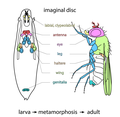Imaginal disc
Imaginal discs are structures in the larvae of insects of the order Diptera, such as Drosophila melanogaster (fruit flies), that contain the cells which will form the adult structures during metamorphosis. These discs undergo extensive growth and morphological changes to give rise to features such as the wings, legs, eyes, and genitalia in the adult insect. Imaginal discs are key to understanding the developmental processes of insects, including cell differentiation, morphogenesis, and the genetic control of development.
Development[edit]
Imaginal discs begin their development in the embryo as clusters of undifferentiated cells that invaginate into the larval body but remain connected to the outer epithelium by a stalk. During larval stages, these discs grow in size but do not differentiate significantly. It is not until the larva undergoes pupation, a stage in the life cycle where the larva transforms into an adult, that the cells within the imaginal discs rapidly proliferate and differentiate to form the structures of the adult insect.
Genetic Control[edit]
The development of imaginal discs is tightly controlled by a network of genes and genetic pathways. Key among these are the homeotic (Hox) genes, which determine the identity of the body segments, and the Notch signaling pathway, which is involved in the differentiation of cells within the discs. The Wingless signaling pathway, another critical pathway, is essential for the proper growth and patterning of the discs.
Types of Imaginal Discs[edit]
There are several types of imaginal discs in Drosophila, each giving rise to different parts of the adult body:
- Wing discs develop into the wings and the dorsal thorax.
- Leg discs form the legs.
- Eye-antennal discs give rise to the eyes and antennae.
- Genital discs are responsible for forming the reproductive organs.
- Haltere discs develop into halteres, which are balancing organs in flies.
Research and Applications[edit]
Imaginal discs have been a model system for studying various aspects of developmental biology. They offer insights into the mechanisms of cell differentiation, organ development, and the genetic control of these processes. Research on imaginal discs has also contributed to understanding how mutations can lead to developmental abnormalities, providing a basis for studying human congenital disorders.
See Also[edit]

This article is a developmental biology stub. You can help WikiMD by expanding it!
Imaginal disc[edit]
-
Imaginal discs of Drosophila
-
Imaginal Disc
Imaginal_disc[edit]
-
Imaginal discs of Drosophila
-
Imaginal Disc
Ad. Transform your life with W8MD's Budget GLP-1 injections from $75


W8MD offers a medical weight loss program to lose weight in Philadelphia. Our physician-supervised medical weight loss provides:
- Weight loss injections in NYC (generic and brand names):
- Zepbound / Mounjaro, Wegovy / Ozempic, Saxenda
- Most insurances accepted or discounted self-pay rates. We will obtain insurance prior authorizations if needed.
- Generic GLP1 weight loss injections from $75 for the starting dose.
- Also offer prescription weight loss medications including Phentermine, Qsymia, Diethylpropion, Contrave etc.
NYC weight loss doctor appointmentsNYC weight loss doctor appointments
Start your NYC weight loss journey today at our NYC medical weight loss and Philadelphia medical weight loss clinics.
- Call 718-946-5500 to lose weight in NYC or for medical weight loss in Philadelphia 215-676-2334.
- Tags:NYC medical weight loss, Philadelphia lose weight Zepbound NYC, Budget GLP1 weight loss injections, Wegovy Philadelphia, Wegovy NYC, Philadelphia medical weight loss, Brookly weight loss and Wegovy NYC
|
WikiMD's Wellness Encyclopedia |
| Let Food Be Thy Medicine Medicine Thy Food - Hippocrates |
Medical Disclaimer: WikiMD is not a substitute for professional medical advice. The information on WikiMD is provided as an information resource only, may be incorrect, outdated or misleading, and is not to be used or relied on for any diagnostic or treatment purposes. Please consult your health care provider before making any healthcare decisions or for guidance about a specific medical condition. WikiMD expressly disclaims responsibility, and shall have no liability, for any damages, loss, injury, or liability whatsoever suffered as a result of your reliance on the information contained in this site. By visiting this site you agree to the foregoing terms and conditions, which may from time to time be changed or supplemented by WikiMD. If you do not agree to the foregoing terms and conditions, you should not enter or use this site. See full disclaimer.
Credits:Most images are courtesy of Wikimedia commons, and templates, categories Wikipedia, licensed under CC BY SA or similar.
Translate this page: - East Asian
中文,
日本,
한국어,
South Asian
हिन्दी,
தமிழ்,
తెలుగు,
Urdu,
ಕನ್ನಡ,
Southeast Asian
Indonesian,
Vietnamese,
Thai,
မြန်မာဘာသာ,
বাংলা
European
español,
Deutsch,
français,
Greek,
português do Brasil,
polski,
română,
русский,
Nederlands,
norsk,
svenska,
suomi,
Italian
Middle Eastern & African
عربى,
Turkish,
Persian,
Hebrew,
Afrikaans,
isiZulu,
Kiswahili,
Other
Bulgarian,
Hungarian,
Czech,
Swedish,
മലയാളം,
मराठी,
ਪੰਜਾਬੀ,
ગુજરાતી,
Portuguese,
Ukrainian


